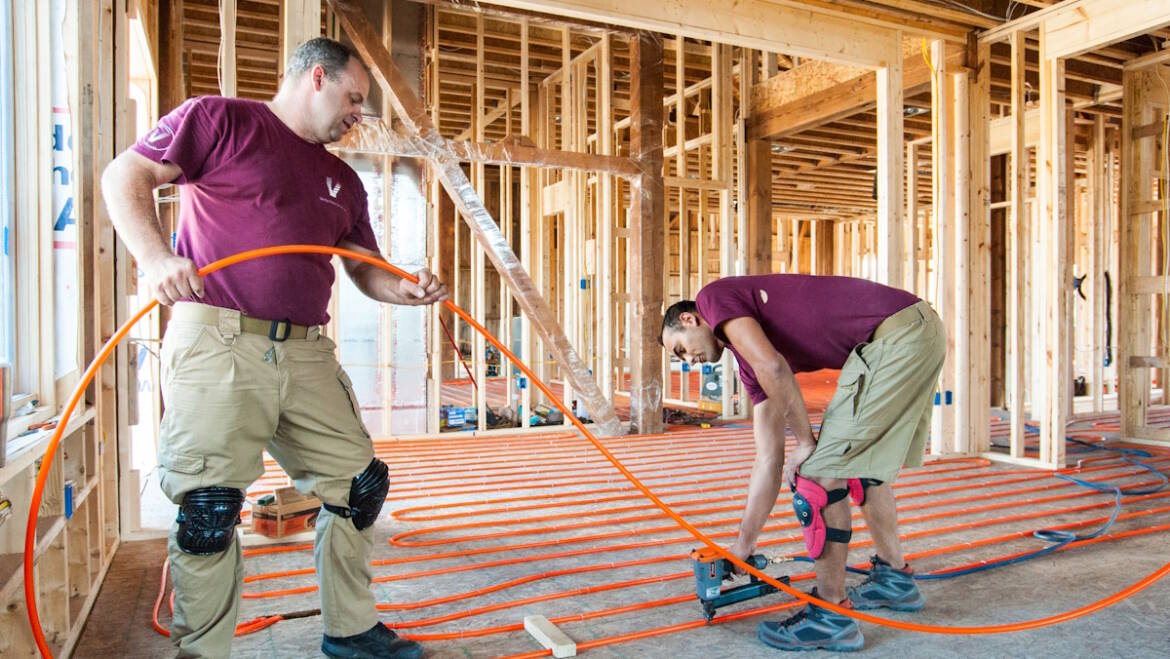Radiant heat is typically seen in commercial spaces like hospital rooftops, parking lots, or even entire cities, and now homeowners are catching on that it’s not only suitable for their home but can help them achieve their comfort and energy needs.
Radiant HVAC has become popular for its ability to deliver even, consistent warmth without the visible components of traditional heating systems. While installation can come with a higher upfront cost, many contractors and homeowners find the long-term benefits far outweigh the initial investment.
All signs point to growth in residential radiant heat as homeowners become more educated about the advantages of radiant heating, and contractors continue to overcome its installation challenges.
Residential Installs
The most common types of radiant heat that contractors are installing in homes today are “staple-up” or “tack-up” systems that involve installing radiant tubing between existing floor plates, and using metal plates to hold the tubing up against the subfloor. Other options are in-slab, or a pour-over of gypcrete.
“We prefer to go on top of subfloors with a gypcrete overpour,” said Vincent Youndt, president of Vertex Mechanical. “I find that we can offset the additional upfront cost of gypcrete because of our ability to use much lower heat levels to get rooms up to comfortable temps. There’s also a significant increase in comfort because of the more uniform heat that a gyp pour has when compared to tack-up systems.”
Youndt went on to say that wood subfloors, compared to gypcrete, simply can’t compete because they don’t have the ability to hold or distribute heat.
“Gypcrete also allows water-to-water geothermal to come into play without taxing the geo up against its maximum parameters,” Youndt said. “Many of our gyp designs have a design day sitting at 105-110°, which is perfect for that type of application.”
In regards to the most common types of residential radiant heating systems he’s seeing, Moe Hirsch, owner of Moe’s Services in Airmont, New York, said, “flooring is a split between staple-down with gypcrete, or extruded plates for retrofit jobs.”
Over in Gypsum, Colorado at Plumbing System Inc., while the market mostly sees residential radiant installs in floor, in concrete, owner Jim Harper said they’re seeing a huge uptick in warm board.
Homeowner Hesitation
The hesitation a homeowner may have about installing a new HVAC system usually revolves around one thing: cost. And installing radiant heat in their homes is no exception. But there are also other concerns.
“A common pushback is not wanting a separate system for cooling,” said Joe Ryan, owner of Peak to Peak Plumbing and Hydronics in Rollinsville, Colorado. “The growing popularity of air-to-water heat pumps, cooling solutions can now complement radiant heating systems without having to have an entire separate system.”
ALL HOMES: Though radiant heating can work in any home, homes with higher ceilings or a lot of tile surfaces have the most to gain. (Courtesy of Watts)
But it usually comes down to cost.
“It’s always cost,” said Youndt. “However, clients that simply are done with drafty or poorly designed air systems seem willing to pay the additional cost. Especially if they feel this is the house they’ll be in for a while.”
And there are a lot of homeowners like this. Contractors just have to ensure they are highlighting that the benefits of these systems far outweigh any hesitation.
“While upfront costs may be higher, we emphasize the efficiency, superior comfort, and added home value that makes these systems a worthwhile investment,” said Ryan.
Misconceptions
Common homeowner misconceptions revolving around what radiant heat would look like in their home have also led to some hesitation. One of these is that if they were to install radiant heat in their floors, their floors would always be hot.
Warm floors are a byproduct, said Hirsch.
“But floors will only be warm so long as the thermostat is calling,” he said. “To make the thermostat call longer time intervals, we install ODR. By injecting just the right amount of heat into the floor and not too much, the radiant will call for hours rather than overshoot and turn off.”
According to Ryan, another misconception is that radiant heating can only be installed on floors, and may damage or be incompatible with certain flooring types.
“We like to educate customers on other options — like radiant walls and ceilings,” said Ryan. “With reduced heating loads due to modern building codes, supply water temperatures are lower, which allows for more flexibility with floor covering options. A well-engineered system will account for all proposed flooring types and catch any potential issues in the design phase.”
Residential radiant heating provides a lot of educational opportunities for homeowners, because the fact is, a lot of them really just don’t understand how it works.
“One of the big educational moments we have with clients around radiant heating is the fact that this heat doesn’t rise,” Youndt said. “Heat moves to cold. We used to do a lot of log homes where there would be a loft over an open living room, and it was always a surprise to the client when we’d tell them that the floor of the loft was important to have heat in, because the heat in the lower level won’t rise — and in fact, the loft could be considerably colder if they didn’t put heat in the floor.”
Benefits To Homeowners
Where radiant heating really shines is the comfort it’s able to provide homeowners. Imagine a freezing winter day, and the floors of the home are warm underfoot.
“[The No. 1 benefit] is comfort — toasty floors when the temperature outdoors plummets,” Hirsch said. “Added benefits include seamless décor — no radiators to get in the way, gentle heat, and it’s cost-effective, especially with a high-efficiency boiler.”
Radiant heating can also provide homeowners with more flexibility for future innovations.
“The systems also allow themselves to easily adapt to changes in technology,” said Ryan. “With low supply water temperatures, these systems are more readily compatible with new trends. Whether it be heat pumps (air-to-water or geothermal), solar thermal, or electric boilers, radiant heating systems are all typically compatible without major changes needed inside the home.”
They can also accommodate those trying to be more energy-conscious.
“We can sometimes talk about energy savings, too — especially with larger homes that have high ceilings or rooms with a lot of glass,” said Youndt. “High bay garages are also pretty easy to sell on the energy savings component.”
Installation Challenges
There are a few installation challenges contractors will want to be aware of before jumping right into a residential radiant heat install.
“Height of the sill plates, door frames, and framing in general need to be accounted for,” Hirsch said.
According to Jim Harper, owner of Plumbing Systems Inc., the most significant challenges a contractor may face when installing radiant heat residentially are “getting supply and return mains from the boiler room to the manifolds, dealing with condensate for snowmelt boilers, and homes with high heat loss loads needing second stage heat.”
To tackle these challenges, contractors have to plan ahead.
“In retrofit applications, it can be more labor-intensive and take extra planning to work around existing utilities and unfavorable building design,” said Ryan.
Another challenge is ensuring all other trades are on board and in communication. This is especially important depending on the design of a home.
“Finding suitable locations in larger homes for remote manifolds can be difficult,” said Ryan. “It is hard to balance discreteness with serviceability at times. Communication between the builder, designer, and homeowner goes a long way.”
Then there’s the obvious workforce challenge — having techs who are skilled at laying out a radiant heating project.
Youndt said the most significant challenges they face are almost always about keeping their materials safe and undamaged while working around the other trades.
“When we have exposed pipes and tubing, there’s huge importance in protecting them from nails, screws, and other things that can penetrate them,” said Youndt. “That’s another reason why we like gypcrete so much. We’re usually laying it out a day or two before a pour, which — as soon as it’s dry — protects our materials pretty well.”
Marketing To Ideal Applications
Really, any home can be a good candidate for radiant heat.
“With more low-mass options available, temperature response times are faster than ever,” said Ryan. “This allows more flexibility and the ability to be installed in most applications.”
Hirsch said retrofit homes with poor insulation generally see the highest client satisfaction with the application.

HESITATION: According to Youndt, there used to be some hesitation among homeowners regarding over-heating in spring and fall, but that really hasn’t been much of an issue since the introduction of modulating-condensing boilers coupled with outdoor reset. (Courtesy of Watts)
Youndt said homes in cold climates, especially homes with higher ceilings or a lot of tile surfaces, have the most to gain from radiant heat, from a comfort standpoint.
“We also find that a lot of retirement communities now have small cottages built on a slab; these are another great application for radiant heat,” Youndt said. “The clientele in these communities swear that the radiant floor helps with circulation and overall health.”
The suitability of radiant heat provides ample marketing opportunities for the service. Radiant heat can work in any type of home: contractors just have to get the word out.
“We really don’t spend any marketing dollars on radiant heat,” said Youndt. “People that want it seem to hunt us down. It’s a smaller crowd for sure. Most of our leads are past clients and those that find us through Google searches.”
And once more homeowners learn that radiant heat is accessible to them, too, and experience its benefits, they’ll continue to talk.
“One happy client brings the next,” Hirsch said. “For new clients, we connect them with a happy client from the past.”
Plumbing Systems markets radiant heat by highlighting its comfort benefits, the long-term value with a higher resale value, and the energy savings it can provide.
The best way to market the systems is by highlighting their benefits. And its benefits usually lead to contractors marketing it as “unmatched.”
“We like to market radiant heating as the most comfortable, healthy, and future-proof heating option,” said Ryan. “With no fans, dust/allergens, unsightly registers, or moving air, we believe that the absence of stimulation to one’s senses makes radiant the clear winner.”
Whether you require installation, repair, or maintenance, our technicians will assist you with top-quality service at any time of the day or night. Take comfort in knowing your indoor air quality is the best it can be with MOE heating & cooling services Ontario's solution for heating, air conditioning, and ventilation that’s cooler than the rest.
Contact us to schedule a visit. Our qualified team of technicians, are always ready to help you and guide you for heating and cooling issues. Weather you want to replace an old furnace or install a brand new air conditioner, we are here to help you. Our main office is at Kitchener but we can service most of Ontario's cities
Source link



